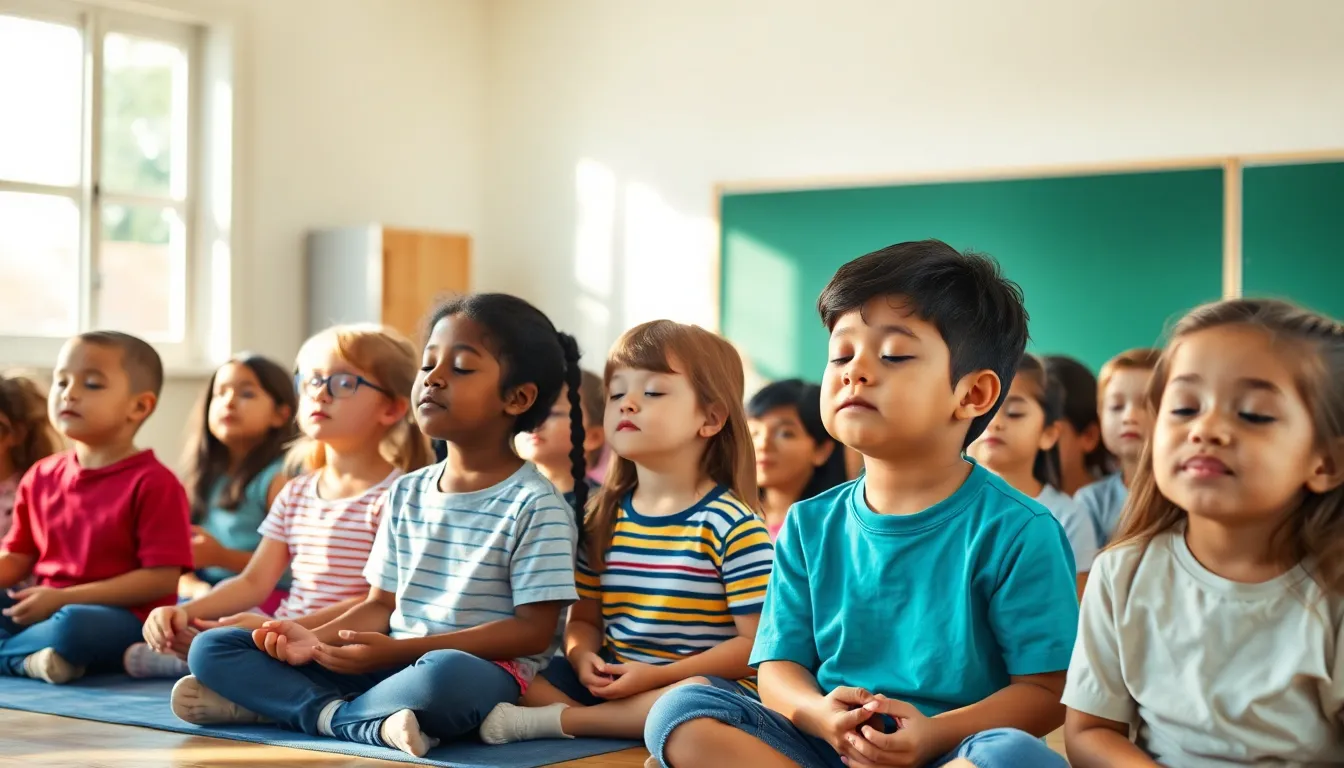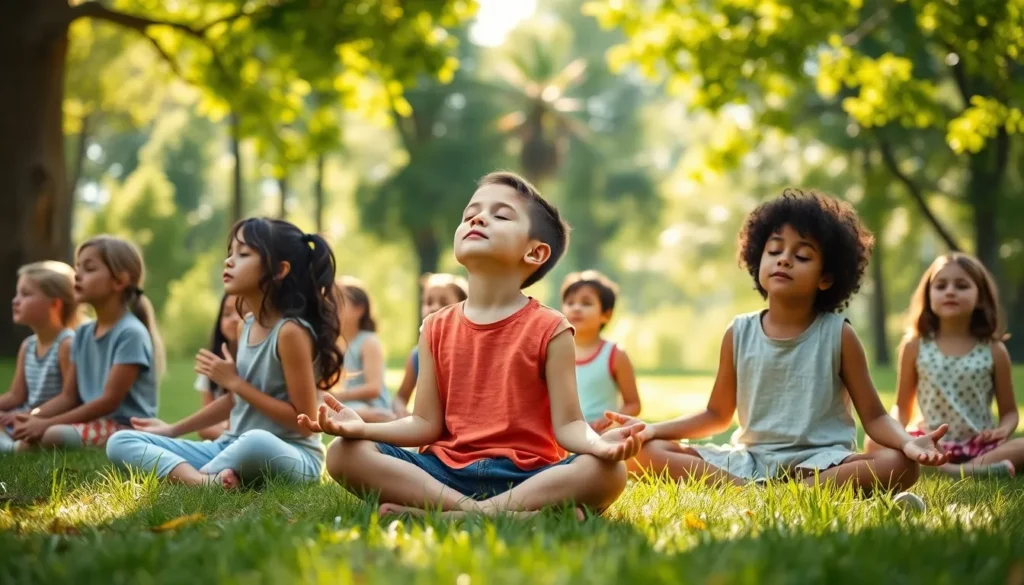Table of Contents
ToggleIn today’s fast-paced world, kids often face overwhelming pressures from school, social media, and extracurricular activities. Amidst this chaos, mindfulness emerges as a powerful tool to help children cultivate awareness and emotional resilience. By practicing mindfulness, kids can learn to focus on the present moment, reducing anxiety and enhancing their overall well-being.
Teaching mindfulness to children not only nurtures their mental health but also fosters essential skills like empathy, patience, and self-regulation. As they develop these skills, children become better equipped to handle life’s challenges. This article explores effective strategies and fun activities that parents and educators can use to introduce mindfulness to kids, setting them on a path toward a calmer, more fulfilling life.
What Is Mindfulness for Kids?
Mindfulness for kids refers to the practice of paying attention to the present moment with curiosity and non-judgment. This approach encourages children to observe their thoughts, feelings, and surroundings without becoming overwhelmed. Mindfulness helps kids develop an understanding of their emotional states, enhancing emotional regulation and resilience.
Applying mindfulness techniques can benefit children by improving focus, reducing stress, and fostering a sense of calm. Common mindfulness activities include breathing exercises, guided imagery, and mindful movement. These activities can be engaging for children while teaching them valuable skills, such as patience and empathy.
In educational settings, implementing mindfulness practices supports a positive learning environment. Teachers can introduce short mindfulness sessions throughout the day, allowing children to center themselves before lessons or transitions. Engaging in collective mindfulness practices helps strengthen social bonds among peers.
Overall, mindfulness for kids provides essential tools for navigating daily challenges. As children learn to be present and aware, they enhance their emotional intelligence and develop a foundation for lifelong well-being.
Benefits of Mindfulness for Children

Mindfulness offers numerous advantages for children’s development and mental well-being. Enhancing emotional regulation and improving focus are pivotal benefits of mindfulness practices.
Emotional Regulation
Emotional regulation refers to a child’s ability to manage and respond to emotional experiences. Mindfulness equips children with tools to recognize their emotions without reacting impulsively. This practice fosters self-awareness, allowing children to pause and reflect before responding to challenging situations. Research indicates that children who engage in mindfulness show increased ability to cope with frustration and anger, reducing instances of aggressive behavior. Children practicing mindfulness techniques, like deep breathing or body scans, can connect with their feelings and develop strategies to manage them effectively.
Improved Focus and Attention
Improved focus and attention stem from mindfulness exercises that train children’s brains to concentrate. Mindfulness practices encourage children to anchor their thoughts in the present moment, enhancing their ability to sustain attention on tasks. Studies reveal that children who engage in mindfulness show increased academic performance and improved task completion rates. Activities such as mindful listening or guided imagery enhance their capacity to focus during lessons and reduce distractions in their environment. Regular mindfulness training strengthens cognitive abilities, allowing children to perform better academically and socially.
Techniques for Practicing Mindfulness
Practicing mindfulness involves various techniques that engage children and encourage present-moment awareness. These techniques can easily be integrated into daily routines.
Breathing Exercises
Breathing exercises focus on controlled breathing to promote relaxation and awareness. Children inhale deeply through their noses, hold for a few seconds, then exhale slowly through their mouths. For example, using the “5-4-3-2-1” technique helps children identify five things they can see, four they can touch, three they can hear, two they can smell, and one they can taste. This exercise reduces anxiety and centers attention on the present moment.
Guided Imagery
Guided imagery involves using imagination to create soothing scenes. Adults can lead children through vivid descriptions of peaceful settings like a beach or a garden, engaging their senses to enhance relaxation. For instance, a guided imagery session might include sounds of waves, the feeling of warm sand, and the scent of flowers, allowing children to visualize themselves in that serene environment. This practice nurtures creativity and reduces stress.
Mindful Movement
Mindful movement combines physical activity with awareness of the body and surroundings. Activities like yoga, tai chi, or simple stretching can help children connect with their bodies. In yoga, for instance, children practice various poses, focusing on their breath and bodily sensations. This encourages mindfulness while enhancing physical coordination and flexibility. Regular mindful movement cultivates a deeper connection between body and mind, promoting overall well-being.
Incorporating Mindfulness into Daily Life
Incorporating mindfulness into daily life helps children develop essential coping skills and emotional resilience. This practice can easily fit into various environments, including school and home.
Mindfulness in School
Mindfulness techniques enrich the learning environment in schools. Teachers can introduce short mindfulness sessions during class, such as breathing exercises or mindful listening activities. These practices foster focus and calmness among students. Studies show that structured mindfulness programs in schools lead to improved academic performance and reduced anxiety levels. Engaging children in activities like guided imagery or mindful walks during breaks can also enhance their emotional regulation and decrease disruptive behaviors.
Mindfulness at Home
Integrating mindfulness into daily home routines supports children’s emotional well-being. Parents can encourage mindfulness through simple activities like focused breathing during family meals or quiet time before bed. Storytelling that emphasizes mindfulness themes further nurtures awareness and empathy in children. Setting aside 5-10 minutes for a family mindfulness practice, such as yoga or meditation, cultivates a supportive atmosphere where children feel safe expressing their feelings. Regular mindfulness practice at home builds habits that promote emotional intelligence and resilience, benefiting children in their interactions and daily challenges.
Embracing mindfulness for kids can significantly enhance their emotional well-being and resilience. By integrating simple mindfulness practices into daily routines, children learn to navigate the complexities of their environment with greater ease. These techniques not only foster self-awareness but also improve focus and reduce stress.
As parents and educators introduce mindfulness activities, they create a supportive atmosphere that encourages emotional intelligence and empathy. This investment in mindfulness equips children with essential skills to face challenges confidently, ultimately guiding them toward a more balanced and fulfilling life. With consistent practice, the benefits of mindfulness can extend far beyond childhood, laying the groundwork for lifelong mental health and well-being.




